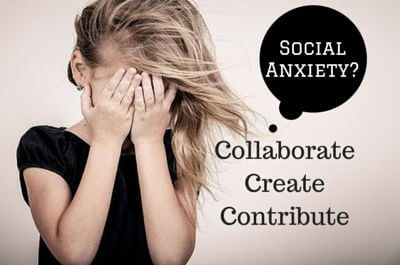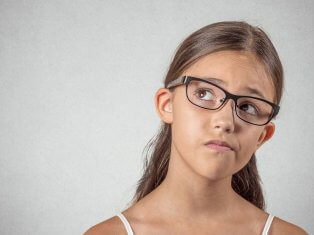
“Social anxiety disorder,” according to the Child Mind Institute, “is characterized by intense self-consciousness and fear of embarrassment that goes beyond common shyness, causing a child to go to great lengths to avoid social interactions,” In other words, a psychologist might suggest that whether your child has social anxiety or a social anxiety disorder is a matter of degree.
Making this determination is decidedly unhelpful though. If you have to ask what type of anxiety your child has, then “Yes” is the answer. If everything were in order, you wouldn’t be asking. But there’s a better way. Got a problem? Don’t diagnose. Do something.
Social anxiety is part of the human condition. On the first day of kindergarten, some kids come charging in the gate and others cling to a parent’s leg. This isn’t about degree of social anxiety. Everyone is anxious. “Will I measure up?” “Will people like me?” “Will I be picked on?” And so on. It’s about strategy. Some kids have figured out that the best defense is a good offense.
In first grade, Maya froze when it was her turn to speak to her class. The very thought of doing a book report in front of her classmates would cause a panic attack. Sometimes, she would be so terrified that the teacher would sit her outside of the circle or in her own corner.
Over the years at parent-teacher conferences, teachers suggested plans to help Maya, like inviting small groups of best friends to their home, not looking at her classmates when she spoke, and various kinds of behavior modifications. No matter what they tried, however, nothing helped. In fact, it seemed to get worse. Being required to speak in front of her class would cause a panic. It was agreed: she had “social anxiety disorder.”
Social Anxiety Disorder? The Diagnosis Distracts.
Then, in fourth grade Maya wrote a great story. Her teacher didn’t simply praise her for nice work; she also showed it to Maya’s former first grade teacher. The first grade teacher invited Maya to read her story to the first graders.
Maya agreed, flattered to have been asked. As the day of her presentation approached, Maya showed no signs of social anxiety. On the day of her presentation, she walked proudly into the room like an actress, sat in the speaker’s chair with twenty-four first-graders at her feet, and read her story with great articulation and flare.
She was so successful at this that Maya’s teacher arranged other speaking engagements, and Maya even performed at an all-school assembly with no signs of stage fright. Yet, Maya still panicked before making a presentation to her own class.
When a child doesn’t respond to our initial attempts to improve behavior, our first response is to try it again. When that still doesn’t work, we might try something else. (Insanity is doing the same thing over and over expecting different results, right?) We keep trying until we run through our entire repertoire of ideas. When we still don’t get what we want, we begin to think: “What’s wrong with this child?” And then we start to diagnose.
“Lazy,” “willful,” and “disobedient” are old favorites, but today we are so much more sophisticated. Today, listening to us talk about students who are experiencing “challenges,” one would think there are only a handful of diseases: Dyslexia, ADHD, Sensory Motor Integration, Social Anxiety Disorder, Executive Function Disorder, “On the Spectrum.”
This is where we go wrong. To say that Maya has “social anxiety disorder” is about as helpful as diagnosing a high temperature as “fever.” Naming a problem usually begs the question of what to do about it. When parents and teachers address the presenting problem directly, they are often trying to help children feel good about themselves or helping them measure up. Telling them “Just be yourself” is equally unhelpful. Ask any kid. “Just be myself? Easy for you to say, I have to belong. You have no idea what I am dealing with.”
Collaborate, Create and Contribute. Skip the Diagnosis.
Most helping doesn’t help because it ignores five obvious things about us humans:
- We know more about our “problem” than anyone else and are working on the problem all the time.
- We are unique.
- We are complex.
- We are not the same person today as we were yesterday.
- (Most importantly) Measuring up doesn’t make us happy; making a difference does.
Fifty years of working with children and teachers has taught me there’s a better way. Beth Campbell, a great kindergarten teacher, once said to me: “I see every unused ability in my class as an incipient behavior problem.” Most classrooms are awash in unused abilities, many of them hidden. One of the core tenets of positive youth development is to focus on strengths rather than disabilities. But what about abilities no one knows about yet?
Good teachers don’t focus on abilities, but agency – the capacity we humans have to act independently and make choices. They count on all students’ natural motivation to collaborate, create and contribute. These are my three C’s for helping students discover and develop the core abilities that matter in their lives.
Humans are wired to make friends, make things, and make a difference. When we put these drives to work, we create our selves. Failure to engage these natural human drives leads to all sorts of behavior problems and undesirable outcomes, including depression, social anxiety, and thoughts of suicide.
Maya’s difficulty speaking in groups is her own unique version of one of the main challenges of being human: how to be our own imperfect self in a group. There is no cure, but there is a strategy: create yourself by making a difference to others. We are wired to love and even to devote ourselves to higher purposes. This strategy may be laced with anxiety, but that’s the challenge of being alive, and it does address three real dis-eases: loneliness, boredom, and worthlessness.
What was the cure for Maya’s “social anxiety disorder?” Maya forgot about her Self and created something. Her teachers saw something of value and collaborated with Maya to contribute it to others. That felt so good, she did it again and again. Instead of “being herself,” she created herself. Her social anxiety didn’t go away. She transcended it by creating, collaborating, and contributing.
Parents and other educators must not be distracted by symptoms. Whatever the dis-ease, the prescription is Collaborate, Create, and Contribute. When we remember the 3 C’s, the disabilities we fear don’t matter so much anymore. It works for us adults, too.
Photo credit: T. Kostareva
Published: June 14, 2016



